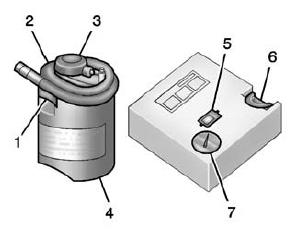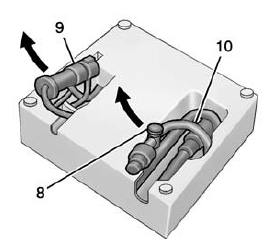Chevrolet Spark Owners Manual: Tire Sealant and Compressor Kit
Warning
Idling a vehicle in an enclosed area with poor ventilation is dangerous. Engine exhaust may enter the vehicle. Engine exhaust contains carbon monoxide (CO) which cannot be seen or smelled.
It can cause unconsciousness and even death. Never run the engine in an enclosed area that has no fresh air ventilation. For more information, see Engine Exhaust on page 9-20.
Warning
Overinflating a tire could cause the tire to rupture and you or others could be injured. Be sure to read and follow the tire sealant and compressor kit instructions and inflate the tire to its recommended pressure. Do not exceed the recommended pressure.
Warning
Storing the tire sealant and compressor kit or other equipment in the passenger compartment of the vehicle could cause injury. In a sudden stop or collision, loose equipment could strike someone. Store the tire sealant and compressor kit in its original location.
If this vehicle has a tire sealant and compressor kit, there may not be a spare tire or tire changing equipment, and on some vehicles there may not be a place to store a tire.
The tire sealant and compressor can be used to temporarily seal punctures up to 6 mm (0.25 in) in the tread area of the tire. It can also be used to inflate an underinflated tire.
If the tire has been separated from the wheel, has damaged sidewalls, or has a large puncture, the tire is too severely damaged for the tire sealant and compressor kit to be effective. See Roadside Assistance Program on page 13-5.
Read and follow all of the tire sealant and compressor kit instructions.
The kit includes: 
- Sealant Canister Inlet Valve
- Sealant/Air Hose
- Base of Sealant Canister
- Tire Sealant Canister
- On/Off Button
- Slot on Top of Compressor
- Pressure Gauge

- Pressure Deflation Button
- Power Plug
- Air Only Hose
- Tire Sealant
- Using the Tire Sealant and Compressor Kit to Temporarily Seal and Inflate a Punctured Tire
- Using the Tire Sealant and Compressor Kit without Sealant to Inflate a Tire (Not Punctured)
 If a Tire Goes Flat
If a Tire Goes Flat
This vehicle has a tire sealant and compressor kit. See Tire Sealant and Compressor
Kit on page 10-56.
There is no spare tire, no tire changing equipment, and no place to store a tire.
It is unusu ...
 Tire Sealant
Tire Sealant
Read and follow the safe handling instructions on the label adhered to the tire
sealant canister (4).
Check the tire sealant expiration date on the tire sealant canister.
The tire sealant canister ...
Other materials:
Engine Compartment Overview
Windshield Washer Fluid Reservoir. See Washer Fluid on page 10-19.
Engine Coolant Surge Tank and Pressure Cap. See Cooling System on page 10-13.
Engine Oil Dipstick. See Engine Oil on page 10-8.
Engine Oil Fill Cap. See Engine Oil on page 10-8.
Engine Cooling Fan (Out of View). See Co ...
Additional Maintenance and Care
Your vehicle is an important investment and caring for it properly may help to
avoid future costly repairs. To maintain vehicle performance, additional maintenance
services may be required.
It is recommended that your dealer perform these services - their trained dealer
technicians know your ...
Traction Control System (TCS)/StabiliTrak Light
The StabiliTrak or Traction Control
System (TCS) indicator/warning light comes on briefly when the engine is started.
If the light does not come on, have the vehicle serviced by your dealer.
If the system is working normally, the indicator light turns off.
If the light is on and not flashing, ...
